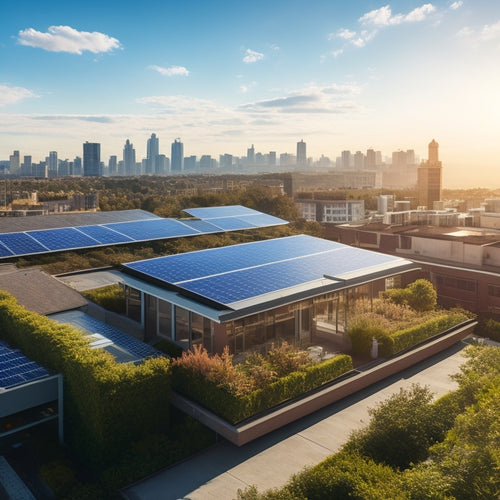Sorting With Solar: Eco-Friendly Solutions for Craft Storage
Share
As you organize your craft space, you're likely seeking functional storage solutions that also support the planet. You're in luck! Harnessing solar power can generate electricity to charge your labeling systems, reducing your reliance on non-renewable energy sources. Meanwhile, eco-friendly materials like hemp textiles, seagrass baskets, and natural fiber bins replace synthetic materials, minimizing waste. Repurposed materials like old wicker baskets and wooden crates offer creative storage options. By integrating solar power and sustainable materials, you'll not only declutter your space but also reduce your carbon footprint. Your journey to a greener craft space is just beginning, and the possibilities are endless.
Key Takeaways
• Integrate solar panels into storage setups to generate electricity and reduce reliance on non-renewable energy sources.
• Use natural fiber alternatives like hemp textiles and seagrass baskets for eco-friendly storage solutions.
• Repurpose discarded materials into unique craft projects to reduce waste and encourage creativity.
• Opt for energy-efficient design elements, such as LED bulbs and skylights, to minimize carbon footprint.
• Implement sustainable shelving options like bamboo storage units, repurposed wooden crates, and upcycled pallet shelves.
Harnessing Solar Power for Storage
As you explore the possibilities of solar power, you'll find that harnessing its energy for storage is essential for a sustainable future.
With the increasing demand for renewable energy sources, solar power has emerged as a viable option for crafters and makers.
By integrating solar panels into your storage setup, you can reduce your reliance on non-renewable energy sources and minimize your carbon footprint.
Energy harvesting through solar panels is a clean and efficient way to power your storage solutions.
You can install solar panels on your workshop or studio's roof to generate electricity, which can then be stored in batteries for later use.
This approach not only reduces your energy consumption but also provides a reliable backup power source during outages.
By embracing solar power, you'll join a community of eco-conscious crafters committed to reducing their environmental impact.
Eco-Friendly Materials for Crafters
As you explore the world of eco-friendly crafting, you're probably wondering what materials you can use to reduce your environmental footprint.
You'll be excited to discover natural fiber alternatives that replace synthetic materials, reusable storage options that minimize waste, and creative ways to repurpose recycled materials into unique crafts.
Natural Fiber Alternatives
You're likely familiar with the environmental drawbacks of traditional crafting materials, which is why you're turning to natural fiber alternatives that not only reduce waste but also promote sustainability.
As a crafter, you understand the importance of minimizing your ecological footprint.
That's where natural fibers come in – a game-changer for eco-conscious crafters like yourself.
Hemp textiles, for instance, offer an excellent alternative to traditional fabrics. Not only do they require less water and pesticides, but they're also stronger and more durable.
Plus, hemp absorbs more CO2 from the atmosphere than many other crops, making it a carbon-negative material.
Another great option is Seagrass baskets, which are biodegradable, compostable, and require minimal resources to produce.
These baskets are perfect for storing small craft supplies, like buttons, threads, or beads.
By choosing natural fiber alternatives, you're supporting sustainable practices and reducing your environmental impact.
Make the switch to hemp textiles and Seagrass baskets, and join a community of crafters committed to preserving the planet for future generations.
Reusable Storage Options
How can you keep your crafting space organized while staying true to your eco-friendly values?
One effective way is by incorporating reusable storage options into your craft room. Fabric bins, for instance, are an excellent alternative to plastic containers. Not only do they add a touch of warmth and coziness to your space, but they're also made from sustainable materials that reduce waste. Look for bins made from natural fibers like cotton, hemp, or jute, which are biodegradable and compostable.
Another clever storage solution is bead organizers. Instead of using individual plastic bags or containers, opt for reusable bead organizers made from eco-friendly materials like recycled paper or bamboo. These innovative storage solutions keep your beads and findings tidy while minimizing your carbon footprint.
Recycled Material Crafts
Transform discarded materials into unique craft projects by harnessing the creative potential of recycled materials, such as old maps, cardboard tubes, or fabric scraps, to reduce waste and give new life to items destined for landfills.
You can turn trash into treasure with a little creativity and imagination. By embracing recycled materials, you're not only reducing waste but also joining a community of eco-conscious crafters who value sustainability.
Artful Junking, a term coined by crafters, refers to the art of transforming discarded materials into beautiful, functional pieces.
It's an opportunity to get creative, think outside the box, and develop a deeper appreciation for the materials you use.
Creative Salvage, another term popular among eco-friendly crafters, encourages you to salvage materials from unexpected sources, like old pallets or broken appliances, and turn them into functional pieces of art.
Sustainable Shelving Options Abound
As you explore sustainable shelving options, you'll discover a world of eco-friendly choices that not only reduce waste but also add a touch of uniqueness to your space.
You'll find that repurposed wooden crates, upcycled pallet shelves, and bamboo storage units offer functional and stylish solutions for your storage needs.
Repurposed Wooden Crates
You can breathe new life into discarded wooden crates by repurposing them as unique shelving units that not only add character to your space but also reduce waste and support a more sustainable lifestyle.
By giving old crates a new purpose, you're reducing the demand for new, resource-intensive materials and keeping waste out of landfills.
With some basic woodworking skills, you can transform crates into functional and stylish shelving units that fit your personal style.
Crate styling is all about embracing the imperfections and uniqueness of each crate, so don't be afraid to get creative!
Start by cleaning and disinfecting the crates, then sand and stain them to bring out their natural beauty.
Add some decorative hardware, and you'll have a one-of-a-kind shelving unit that's both eco-friendly and Instagram-worthy.
Upcycled Pallet Shelves
With a staggering 2 billion pallets in circulation globally, it's no wonder upcycled pallet shelves have become a sustainable darling in the world of eco-friendly storage solutions.
You, too, can tap into this pallet potential by transforming discarded pallets into functional and stylish storage units. Imagine having a dedicated space for your crafting supplies, neatly organized and within reach.
Upcycled pallet shelves offer endless shelf styling possibilities, from rustic and distressed to modern and sleek. You can customize them to fit your unique crafting style and space constraints.
Plus, by giving new life to old pallets, you're reducing waste and supporting a more circular economy. As you venture into this eco-friendly adventure, remember to get creative with your pallet selection, considering factors like sturdiness, size, and visual appeal.
With a little TLC and some DIY magic, you'll be enjoying your very own upcycled pallet shelves in no time – and doing the planet a favor, too!
Bamboo Storage Units
Bamboo storage units emerge as a game-changer in the quest for sustainable shelving, offering a highly renewable, low-carbon alternative to traditional materials.
As you explore eco-friendly options for your craft storage, you'll find that bamboo stands out for its remarkable durability and versatility.
With a lifespan of up to 20 years, bamboo storage units can withstand the wear and tear of frequent use, making them an excellent choice for busy crafters.
One of the most significant advantages of bamboo is its aesthetic versatility.
Whether you're drawn to modern minimalism or rustic charm, bamboo storage units can be designed to fit seamlessly into your craft space.
From sleek, compact shelves to spacious, multi-tiered units, the design possibilities are endless.
Plus, bamboo's natural beauty adds a touch of warmth and coziness to any room, creating a welcoming atmosphere that inspires creativity.
Solar-Charged Labeling Systems
Nearly 90% of labeling systems used in warehouses and distribution centers still rely on battery-powered scanners, but solar-charged labeling systems are emerging as a sustainable alternative.
As you explore eco-friendly solutions for your craft storage, consider the benefits of solar-charged labeling systems.
These innovative systems use solar power to charge labels, reducing your reliance on batteries and minimizing electronic waste. You can enjoy the convenience of labeling your craft supplies while reducing your carbon footprint.
Renewable Energy
Harness the power of the sun to charge your labels, reducing your reliance on non-renewable energy sources.
Sustainable
Solar-charged labeling systems reduce electronic waste and minimize the demand for batteries.
Cost-Effective
With solar power, you can save money on battery replacements and reduce your energy costs.
Easy to Use
Solar-charged labeling systems are designed for ease of use, making it simple to label and organize your craft supplies.
Green Crafting Communities Unite
As you join the ranks of eco-conscious crafters, you'll find that green crafting communities are thriving, offering a supportive space to share sustainable practices and inspire like-minded individuals to make a collective impact.
These communities, often structured as Crafting Guilds, bring together Eco Artists and environmentally aware crafters to exchange ideas and resources.
Green Meetups and online forums provide a platform for Creative Activism, where members can discuss Environmental Ethics and sustainable practices in the crafting world.
By joining these Sustainable Networks, you'll gain access to a wealth of knowledge and inspiration, empowering you to make a positive impact on the environment.
You'll discover innovative ways to reduce waste, repurpose materials, and incorporate eco-friendly techniques into your craft.
As you connect with others who share your passion for the planet, you'll find a sense of belonging and motivation to continue making a difference.
Together, you can create a movement that transforms the crafting world into a more sustainable, environmentally conscious community.
Repurposed Materials for Storage
Repurposing materials for storage is a clever way to reduce waste and breathe new life into items that would otherwise end up in landfills, all while keeping your crafting space organized and eco-friendly. By getting creative with storage, you'll not only reduce your environmental footprint but also add a touch of personality to your craft room.
-
Vintage Luggage: Transform old suitcases into storage containers for your crafting supplies. Simply clean and decorate them to match your craft room's aesthetic.
-
Old Sacks: Reuse burlap sacks or coffee bean bags to store yarn, threads, or other materials. They add a rustic touch to your space while keeping your supplies organized.
-
Wicker Baskets: Upcycle old wicker baskets to store papers, fabrics, or other crafting essentials. They bring a natural, earthy feel to your space.
- Mason Jars: Use mason jars to store small items like buttons, beads, or other tiny crafting supplies. They're easy to label and add a touch of rustic charm to your craft room.
Energy-Efficient Craft Room Design
By incorporating energy-efficient design elements, you can reduce your craft room's carbon footprint and create a more sustainable creative space that not only benefits the environment but also saves you money on your utility bills.
One essential aspect of energy-efficient design is Craft Lighting. Opt for LED bulbs, which consume substantially less energy than traditional incandescent bulbs. Additionally, consider installing skylights or larger windows to maximize natural light, reducing the need for artificial lighting.
This not only reduces energy consumption but also creates a more inviting and comfortable workspace.
Effective Space Planning is also vital in creating an energy-efficient craft room. Assess your workspace and identify areas where energy can be saved.
For instance, consider placing your most frequently used supplies near a natural light source, reducing the need for artificial lighting.
Illuminating the Path to Zero Waste
Sorting solar-powered lights into your craft room design can substantially reduce electronic waste and pave the way to a zero-waste creative space.
By adopting sustainable habits, you'll not only minimize your environmental footprint but also cultivate a sense of community among like-minded individuals who share your passion for eco-friendliness.
To illuminate the path to zero waste, consider the following strategies:
Conduct a craft room audit: Identify areas where you can reduce, reuse, and recycle materials, and implement changes accordingly.
Choose eco-friendly materials: Opt for sustainable materials, such as recycled paper and biodegradable craft supplies, to minimize waste generation.
Implement a 'one in, one out' policy: Guarantee that for every new craft supply you bring in, an old one is removed or repurposed, maintaining a balanced and waste-free space.
Upcycle and repurpose materials: Get creative with materials you might otherwise discard, and transform them into unique craft projects or storage solutions.
Frequently Asked Questions
Can I Use Solar Panels to Power My Sewing Machine?
You can power your sewing machine with solar energy, reducing your carbon footprint and increasing energy efficiency. Invest in a suitable solar panel system, and you'll be sewing sustainably in no time, feeling good about your eco-friendly solar sewing setup!
How Do I Properly Recycle Old Craft Supplies?
"Before trashing old craft supplies, consider hosting a Supply Swap with friends or donating materials to local schools or community centers, reducing waste and fostering a sense of community."
Are There Any Eco-Friendly Alternatives to Plastic Storage Bins?
You're looking for eco-friendly alternatives to plastic storage bins? You'll love bamboo containers and recycled crates, sustainable options that reduce waste and promote a greener crafting space, aligning with your values and passion for the planet.
Can I Use Rainwater to Clean My Craft Room Floors?
You can harness rainwater for cleaning your craft room floors, embracing Rainwater Harvesting to reduce your water footprint. This eco-friendly approach also aids in Floor Sanitizing, ensuring a clean and healthy space for your creative pursuits.
Are There Any Grants Available for Eco-Friendly Craft Rooms?
"You can explore eco-grants, creative funding, and artistic subsidies to support your eco-friendly craft room dreams! Research organizations like the National Endowment for the Arts, Environmental Protection Agency, and local green initiatives for potential funding opportunities."
Related Posts
-

Why Electric Motorcycles Fail at Long-Distance Touring
You're likely familiar with the excitement of hitting the open road on an electric motorcycle, but you're also smart ...
-

What Is the Cost to Put in Solar Panels
You're likely considering solar panels for your home, and the most significant factor in your decision is the upfront...
-

3 Essential Steps for Solar Electricity Installation
To guarantee a successful solar electricity installation, you'll need to follow three essential steps. First, assess ...


